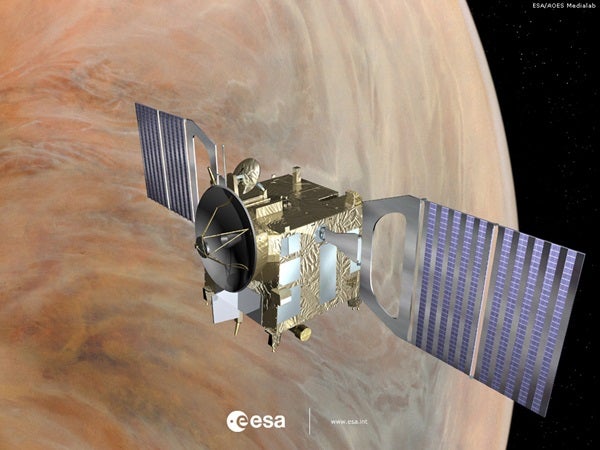Venus Express has made the first detection of an atmospheric loss process on Venus’ dayside. Last year the spacecraft revealed that most of the lost atmosphere escapes from the nightside. Together, these discoveries bring planetary scientists closer to understanding what happened to the water on Venus, which is suspected to have once been as abundant as on Earth.
The spacecraft’s magnetometer instrument (MAG) detected the unmistakable signature of hydrogen gas being stripped from the dayside. “This is a process that was believed to be happening at Venus, but this is the first time we measured it,” said Magda Delva, Austrian Academy of Sciences, Graz, who leads the investigation.
Thanks to its carefully chosen orbit, Venus Express is strategically positioned to investigate this process. The spacecraft travels in a highly elliptical path that sweeps over the poles of the planet.
Water is a key molecule on Earth because it makes life possible. With Earth and Venus approximately the same size and having formed at the same time, astronomers believe both planets likely began with similar amounts of the liquid. Today, however, the proportions on each planet are extremely different. Earth’s atmosphere and oceans contain 100,000 times the total amount of water on Venus. In spite of the low concentration of water on Venus, Delva and colleagues found that Venus’ dayside was losing some 2×1024 hydrogen nuclei, a constituent atom of the water molecule, every second.
Last year, the Analyzer of Space Plasma and Energetic Atoms (ASPERA) aboard Venus Express showed that there was a great loss of hydrogen and oxygen on the nightside. Roughly twice as many hydrogen atoms as oxygen atoms were escaping. Because water is made of two hydrogen atoms and one oxygen atom, the observed escape indicates that water is being broken up in the atmosphere of Venus.
The Sun not only emits light and heat into space, but it also constantly spews out solar wind, a stream of charged particles. This solar wind carries electrical and magnetic fields throughout the solar system and “blows” past the planets.
Unlike Earth, Venus does not generate a magnetic field. This is significant because Earth’s magnetic field protects its atmosphere from the solar wind. At Venus, however, the solar wind strikes the upper atmosphere and carries off particles into space. Planetary scientists think the planet has lost part of its water in this way over the 4½ thousand million years since the planet’s birth.
“We do see water escaping from the nightside. But the question remains: How much has been lost in the past in this way?” said Stas Barabash, Swedish Institute of Space Physics, Kiruna and Principal Investigator of ASPERA, who looked at nightside data.
The discovery takes scientists a step toward understanding the details, but it does not provide the last piece of the puzzle. To be certain that the hydrogen is coming from water, Delva and colleagues also must detect the loss of oxygen atoms on the dayside and verify that there are approximately half as many leaving Venus as hydrogen.
So far, this has not been possible. “I keep looking at the magnetometer data but so far I can’t see the signature of oxygen escaping on the dayside,” said Delva.
It also highlights a new mystery. “These results show that there could be at least twice as much hydrogen in the upper atmosphere of Venus than we thought,” said Delva. The detected hydrogen ions could exist in atmospheric regions high above the surface of the planet, but scientists don’t know the source of these regions.
So like a true lady, Venus still retains some of her mystery.










